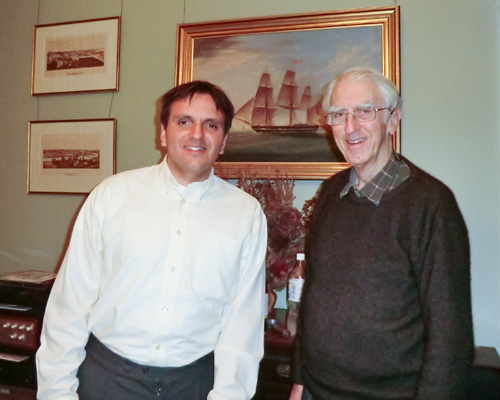
Peter Pockley (right) at his his home in Sydney in 2011 with Matin Durrani.
By Matin Durrani
Physics World was saddened to learn today – via a Tweet from the Australian Nobel-prize-winning astronomer Brian Schmidt – of the death of veteran Australian science journalist Peter Pockley.
Peter, who was 78, had contributed numerous articles to Physics World over the years, focusing mainly on the ups and downs of science policy in Australia, of which he had an in-depth knowledge. He died peacefully at his home in Sydney on 11 August 2013.
We were surprised at the news as Peter had written to us barely three weeks ago with detailed suggestions for follow-up coverage of the opening of the Murchison Widefield Array in Western Australia, which we reported on last month. Peter had also arranged to visit the UK next month with his wife Jenny to attend a reunion to mark the 750th anniversary of Balliol College, Oxford, where he had studied chemistry. I had e-mailed Peter to suggest he visit us at the Physics World offices in Bristol – as he had done on a similar occasion in 2000 – but Peter was disappointed to have to decline our offer as his schedule was “immovably tight”. He had, though, promised to call me over the phone while he was in the UK.
According to a report on Australian Science, Peter was the first ever scientist to work full-time as a science reporter and producer in the Australian media – taking up the honour in 1964 – and became founding head of science programmes at the Australian Broadcasting Corporation (ABC), where he set up the Science Unit for TV and Radio. He later hosted ABC’s radio coverage of all of NASA’s Apollo missions, before becoming head of public affairs at the University of New South Wales, running science-journalism courses at the University of Technology, Sydney, and serving as a freelance writer for publications such as Nature, as well as Physics World.
In 2010 Peter was awarded the Australian Academy of Science Medal, which is given to a person who is not a fellow of the academy but has “significantly advanced the cause of science and technology in Australia”.
I met Peter again in 2011 while I was on a tour of Australia with a group of fellow science journalists from Europe that had been organized by the Australian government. On my visit, Peter took me on a boat trip across Sydney harbour, during which I was given a colourful account of the history of the city, and we enjoyed a meal of fish and chips on arrival at the beach resort of Manly. A few days later, Peter invited for me dinner at his house, where he introduced me to Australian science-policy analyst Thomas Barlow, whose wife is the highly regarded quantum physicist Michelle Simmons. Before my arrival, Peter had also e-mailed with a wealth of tips for me to get the most out of my trip to Australia.
I mention all these things because they had all been arranged by Peter entirely on his own initiative as he sought to give me extra insights into Australia and the country’s science. I can only suspect they were typical of his generosity of time and spirit.
Guidelines
Show/hide formatting guidelines
this text was deletedwhere people live in harmony with nature and animals</q>
Some text